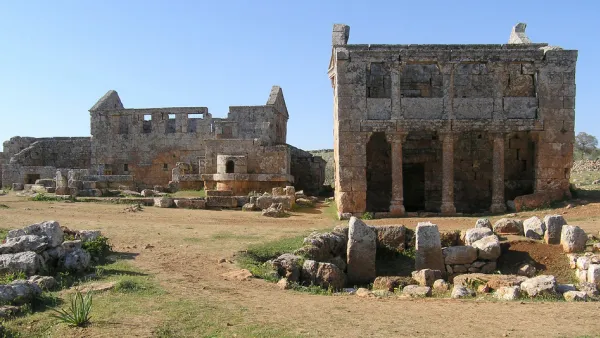It's still far from clear what the political outcome of Syria's civil war will be. But for the country's built environment, the effects are stunningly evident. Millions of buildings have been damaged or destroyed since March 2011.
Compared to the estimated 30,000 killed during the war, the widespread damage and destructuion of Syria's homes, schools, mosques, churches and hospitals is but a footnote. But the truth remains that "[m]uch of Syria has become a disaster zone."
According to Los Angeles Times staff, "[o]n streets once lined with multistory buildings and mosques, ceilings lie pancaked atop smashed and dusty home furnishings and appliances. Electrical wires hang like carelessly strung streamers across concrete columns strewn with antigovernment graffiti. Roads in front of gutted shops have become impassable for the sheer amount of rubble."
As we noted before, some of the world's most treasured historical sites have been damaged in the fighting. With a new law that allows for the demolition of "illegally contructed buildings," the government is opening a new front in the destrcution of the social fabric of the country. "More than half the buildings in Damascus are illegally built, in part because the country's urban planning hasn't been updated in 40 years, said Radwan Ziadeh, director of the Damascus Center for Human Rights and a member of the opposition Syrian National Council."
"The main idea behind [the law] was to punish all these areas where they have a strong presence of the Free Syrian Army," Ziadeh said. "They need to destroy the social support" for the rebels in Damascus and the suburbs.
"The regime is using the excuse of urban planning to demolish entire buildings," said Lena Shami, an activist in Damascus. "But what are the chances that it ignored the issue for all these years and now remembered it? And they haven't given residents any warning or reimbursement."
FULL STORY: Conflict has left Syria a shell of its former self

Analysis: Cybertruck Fatality Rate Far Exceeds That of Ford Pinto
The Tesla Cybertruck was recalled seven times last year.

National Parks Layoffs Will Cause Communities to Lose Billions
Thousands of essential park workers were laid off this week, just before the busy spring break season.

Retro-silient?: America’s First “Eco-burb,” The Woodlands Turns 50
A master-planned community north of Houston offers lessons on green infrastructure and resilient design, but falls short of its founder’s lofty affordability and walkability goals.

Test News Post 1
This is a summary

Analysis: Cybertruck Fatality Rate Far Exceeds That of Ford Pinto
The Tesla Cybertruck was recalled seven times last year.

Test News Headline 46
Test for the image on the front page.
Urban Design for Planners 1: Software Tools
This six-course series explores essential urban design concepts using open source software and equips planners with the tools they need to participate fully in the urban design process.
Planning for Universal Design
Learn the tools for implementing Universal Design in planning regulations.
EMC Planning Group, Inc.
Planetizen
Planetizen
Mpact (formerly Rail~Volution)
Great Falls Development Authority, Inc.
HUDs Office of Policy Development and Research
NYU Wagner Graduate School of Public Service


























